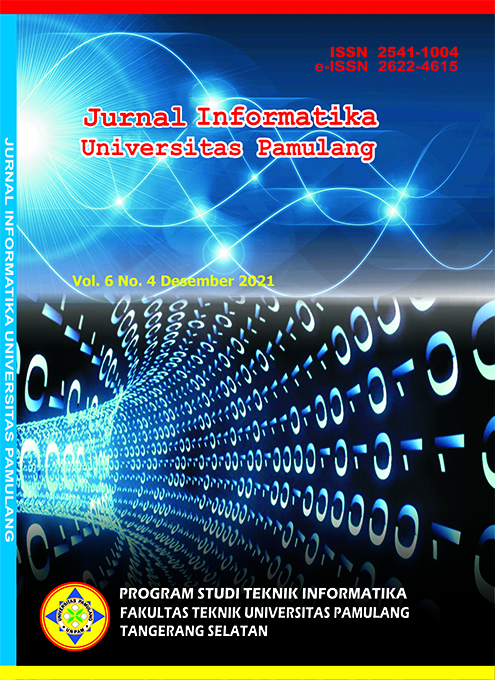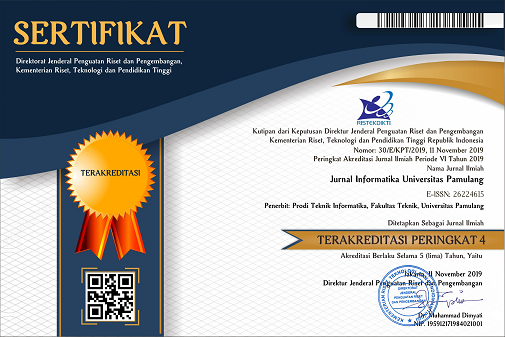K-Means Algorithm in Grouping Central Civil Servants by Agencies and Groups in Pematangsiantar
DOI:
https://doi.org/10.32493/informatika.v6i4.14122Keywords:
Grouping, Civil Servants, K-Means Algorithm, Data Mining, Institutions GovernmentAbstract
Civil Servants (PNS) are Indonesian citizens who have certain conditions and are given the mandate to be a State Civil Apparatus on a permanent basis and are not bound by a contract to carry out their assigned duties and positions. There is a view that states that civil servants have useful guarantees in the future and there is no contract system in work. Each government has civil servants with different groups. This study aims to group the central civil servants according to agencies and groups in Pematangsiantar. In completing this research, it was carried out using the k-means algorithm. The data used in the study came from the Central Statistics Agency (BPS) by processing the data into 3 clusters, namely high, medium, and low. The results of this study indicate that the k-means algorithm can be applied in determining the grouping of Central Civil Servants by Agencies and Groups in Pematangsiantar with the results that 1 item is high (C1), 4 items are medium (C2), and 21 items are low (C3).References
Aditya, A., Jovian, I., & Sari, B. N. (2020). Implementasi K-Means Clustering Ujian Nasional Sekolah Menengah Pertama di Indonesia Tahun 2018/2019. Jurnal Media Informatika Budidarma, 4(1), 51. https://doi.org/10.30865/mib.v4i1.1784
Agustin, F. E. M. (2015). Implementasi Algoritma K-Means Untuk Menentukan Kelompok Pengayaan Materi Mata Pelajaran Ujian Nasional (Studi Kasus: Smp Negeri 101 Jakarta). Jurnal Teknik Informatika, 8(1), 73–78. https://doi.org/10.15408/jti.v8i1.1938
Gustientiedina, G., Adiya, M. H., & Desnelita, Y. (2019). Penerapan Algoritma K-Means Untuk Clustering Data Obat-Obatan. Jurnal Nasional Teknologi Dan Sistem Informasi, 5(1), 17–24. https://doi.org/10.25077/teknosi.v5i1.2019.17-24
Irnanda, K. F., Windarto, A. P., Damanik, I. S., & ... (2019). Penerapan K-Means pada Proporsi Individu dengan Keterampilan (Teknologi Informasi dan Komunikasi) TIK Menurut Wilayah. … Teknologi Informasi …, c, 452–456.
Maulida, L. (2018). Penerapan Datamining Dalam Mengelompokkan Kunjungan Wisatawan Ke Objek Wisata Unggulan Di Prov. Dki Jakarta Dengan K-Means. JISKA (Jurnal Informatika Sunan Kalijaga), 2(3), 167. https://doi.org/10.14421/jiska.2018.23-06
Nasution, Y. R., & Eka, M. (2018). Penerapan Algoritma K-Means Clustering Pada Aplikasi Menentukan Berat Badan Ideal. Jurnal Ilmu Komputer Dan Informatika, 02(April), 77–81.
Nurzahputra, A., Muslim, M. A., & Khusniati, M. (2017). Penerapan Algoritma K-Means Untuk Clustering Penilaian Dosen Berdasarkan Indeks Kepuasan Mahasiswa. Techno.Com, 16(1), 17–24. https://doi.org/10.33633/tc.v16i1.1284
Parlina, I., Windarto, A. P., Wanto, A., & Lubis, M. R. (2018). Memanfaatkan Algoritma K-Means Dalam Menentukan Pegawai Yang Layak Mengikuti Asessment Center. Memanfaatkan Algoritma K-Means Dalam Menentukan Pegawai Yang Layak Mengikuti Asessment Center Untuk Clustering Program Sdp, 3(1), 87–93.
Rosmini, R., Fadlil, A., & Sunardi, S. (2018). Implementasi Metode K-Means Dalam Pemetaan Kelompok Mahasiswa Melalui Data Aktivitas Kuliah. It Journal Research and Development, 3(1), 22–31. https://doi.org/10.25299/itjrd.2018.vol3(1).1773
Wardhani, A. K. (2016). Implementasi Algoritma K-Means untuk Pengelompokkan Penyakit Pasien pada Puskesmas Kajen Pekalongan. Jurnal Transformatika, 14(1), 30–37.
Downloads
Published
Issue
Section
License
Authors who publish with this journal agree to the following terms:
- Authors retain copyright and grant the journal right of first publication with the work simultaneously licensed under a Creative Commons Attribution-NonCommercial 4.0 International (CC BY-NC 4.0) that allows others to share the work with an acknowledgement of the work's authorship and initial publication in this journal.
- Authors are able to enter into separate, additional contractual arrangements for the non-exclusive distribution of the journal's published version of the work (e.g., post it to an institutional repository or publish it in a book), with an acknowledgement of its initial publication in this journal.
- Authors are permitted and encouraged to post their work online (e.g., in institutional repositories or on their website) prior to and during the submission process, as it can lead to productive exchanges, as well as earlier and greater citation of published work (See The Effect of Open Access).
Jurnal Informatika Universitas Pamulang have CC-BY-NC or an equivalent license as the optimal license for the publication, distribution, use, and reuse of scholarly work.
In developing strategy and setting priorities, Jurnal Informatika Universitas Pamulang recognize that free access is better than priced access, libre access is better than free access, and libre under CC-BY-NC or the equivalent is better than libre under more restrictive open licenses. We should achieve what we can when we can. We should not delay achieving free in order to achieve libre, and we should not stop with free when we can achieve libre.
Jurnal Informatika Universitas Pamulang is licensed under a Creative Commons Attribution-NonCommercial 4.0 International (CC BY-NC 4.0)
YOU ARE FREE TO:
- Share : copy and redistribute the material in any medium or format
- Adapt : remix, transform, and build upon the material for any purpose, even commercially.
- The licensor cannot revoke these freedoms as long as you follow the license terms





